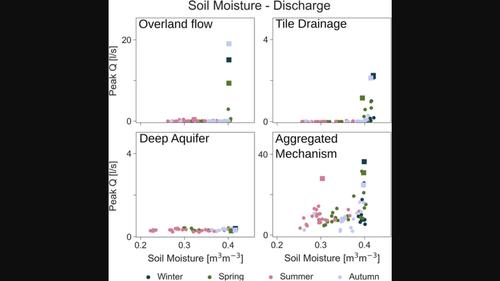当前位置:
X-MOL 学术
›
Hydrol. Process.
›
论文详情
Our official English website, www.x-mol.net, welcomes your
feedback! (Note: you will need to create a separate account there.)
Non-linearity in event runoff generation in a small agricultural catchment
Hydrological Processes ( IF 2.8 ) Pub Date : 2022-08-08 , DOI: 10.1002/hyp.14667 Mariette Vreugdenhil 1, 2 , Borbála Széles 2, 3 , José Luis Salinas 2, 3 , Peter Strauß 4 , Markus Oismueller 2 , Patrick Hogan 2, 3 , Wolfgang Wagner 1, 2 , Juraj Parajka 2, 3 , Günter Blöschl 2, 3
Hydrological Processes ( IF 2.8 ) Pub Date : 2022-08-08 , DOI: 10.1002/hyp.14667 Mariette Vreugdenhil 1, 2 , Borbála Széles 2, 3 , José Luis Salinas 2, 3 , Peter Strauß 4 , Markus Oismueller 2 , Patrick Hogan 2, 3 , Wolfgang Wagner 1, 2 , Juraj Parajka 2, 3 , Günter Blöschl 2, 3
Affiliation

|
Understanding the role of soil moisture and other controls in runoff generation is important for predicting runoff across scales. This paper aims to identify the degree of non-linearity of the relationship between event peak runoff and potential controls for different runoff generation mechanisms in a small agricultural catchment. The study is set in the 66 ha Hydrological Open Air Laboratory, Austria, where discharge was measured at the catchment outlet and for 11 sub-catchments or hillslopes with different runoff generation mechanisms. Peak runoff of 73 events was related to three potential controls: event precipitation, soil moisture and groundwater levels. The results suggest that the hillslopes dominated by ephemeral overland flow exhibit the most non-linear runoff generation behaviour for its controls; runoff is only generated above a threshold of 95% of the maximum soil moisture. Runoff generation through tile drains and in wetlands is more linear. The largest winter and spring events at the catchment outlet are caused by runoff from hillslopes with shallow flow paths (ephemeral overland flow and tile drainage mechanisms), while the largest summer events are caused by other hillslopes, those with deeper flow paths or with saturation areas throughout the year. Therefore, the response of the entire catchment is a mix of the various mechanisms, and the groundwater contribution makes the response more linear. The implications for hydrological modelling are discussed.
中文翻译:

小型农业流域事件径流生成的非线性
了解土壤湿度和其他控制因素在径流产生中的作用对于预测跨尺度径流非常重要。本文旨在确定小型农业流域中不同径流生成机制的事件峰值径流与潜在控制之间关系的非线性程度。该研究以奥地利 66 公顷水文露天实验室为背景,测量了流域出口和 11 个具有不同径流生成机制的子流域或山坡的流量。 73 个事件的峰值径流与三个潜在控制因素相关:事件降水、土壤湿度和地下水位。结果表明,以短暂地表径流为主的山坡对其控制表现出最非线性的产流行为;仅在最大土壤湿度 95% 的阈值以上才会产生径流。通过瓷砖排水沟和湿地产生的径流更加线性。流域出口处最大的冬季和春季事件是由具有浅流道的山坡(短暂的地表径流和瓦排水机制)的径流引起的,而最大的夏季事件是由其他山坡、具有较深流道或饱和区的山坡引起的全年。因此,整个流域的响应是各种机制的混合,地下水的贡献使响应更加线性。讨论了水文建模的含义。
更新日期:2022-08-08
中文翻译:

小型农业流域事件径流生成的非线性
了解土壤湿度和其他控制因素在径流产生中的作用对于预测跨尺度径流非常重要。本文旨在确定小型农业流域中不同径流生成机制的事件峰值径流与潜在控制之间关系的非线性程度。该研究以奥地利 66 公顷水文露天实验室为背景,测量了流域出口和 11 个具有不同径流生成机制的子流域或山坡的流量。 73 个事件的峰值径流与三个潜在控制因素相关:事件降水、土壤湿度和地下水位。结果表明,以短暂地表径流为主的山坡对其控制表现出最非线性的产流行为;仅在最大土壤湿度 95% 的阈值以上才会产生径流。通过瓷砖排水沟和湿地产生的径流更加线性。流域出口处最大的冬季和春季事件是由具有浅流道的山坡(短暂的地表径流和瓦排水机制)的径流引起的,而最大的夏季事件是由其他山坡、具有较深流道或饱和区的山坡引起的全年。因此,整个流域的响应是各种机制的混合,地下水的贡献使响应更加线性。讨论了水文建模的含义。











































 京公网安备 11010802027423号
京公网安备 11010802027423号